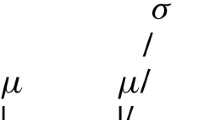Abstract
Paradigm leveling, whereby the number of surface allomorphs within a paradigm is reduced, is often accompanied by the loss of contrast between paradigms (analogy). Since these two are independent of each other, we distinguish between intra- and inter-paradigm leveling. In this paper, we study inter-paradigm leveling in the verb system of Hebrew, manifested by on-going change-oriented variation. In this context, we respond to two questions often addressed in studies on paradigm leveling: (i) Why do some paradigms interact in inter-paradigm leveling and others do not? (ii) What determines the direction of leveling? With regard to the first question, we argue that inter-paradigm leveling is triggered by similarity between whole paradigms, and propose a model that quantifies similarity and predicts the relative chance for two paradigms to undergo inter-paradigm leveling. With regard to the second question, we identify two types of directionality, uni- and bidirectional leveling, and show that the selection between these two is determined by the size of the inflectional classes. Class size determines the direction in unidirectional leveling (the larger is the winner) and class size ratio distinguishes between uni- and bidirectional leveling (the higher the ratio the greater the chance for unidirectional leveling).
Similar content being viewed by others
Notes
We refrain from using the term ‘analogy’ because it is not specific enough for our purpose, or as Bybee (1980:45) phrased this term “encompasses both too much and too little”. See Kraska-Szlenk (2007) and Blevins and Blevins (2009) for recent reviews of analogy in linguistics, and Itkonen (2005) for the wide spread use of analogy in linguistics and cognitive science.
The notation <X–…–Y>, where X and Y are forms in a paradigm, indicate a whole paradigm.
The term ‘paradigm’ partially overlaps with the term ‘lexeme’ (see definition in Aronoff and Fudeman 2011).
The ‘morpho-syntactic dimension’ is the combination of the morpho-syntactic features relevant to the paradigm. The features relevant for the present study are tense (past and future), number (singular and plural), gender (masculine and feminine), and person (1st, 2nd, and 3rd).
Some studies refer to 7 binyanim, counting the passive forms of B3 and B4.
Historically, the normative 1st person singular Future form (prefix ʔV-) has been replaced with the 3rd person singular form (prefix jV-). Although the change is on-going, we are using here the syncretic form.
Unless otherwise specified, the citation form is 3rd person masculine Past form with a gloss in the infinitive.
Tarmon and Uval (1998) list 64 distinct B1 sub-classes. However, since we consider here the past and future tenses only (ignoring the present, imperative, and infinitive), we end up with 45 distinct sub-classes.
Actually, Bolozky (2003) shows that the distinction between ʔ and ʕ has been a bit fragile already in Biblical Hebrew. This is evident by a few words, which are spelled with the letter corresponding to ʔ in some places and with the letter corresponding to ʕ in others.
A reviewer noted that a whole paradigm migration entails that for a given speaker all forms change at once. This is not entirely accurate since speakers may use the old paradigm in high-register contexts and the new one in casual contexts. Hyper-correction in high-register contexts make the situation even more complex. As long as there is variation, it is impossible to “prove” that the entire paradigm migrates; the only proof is in the end-state. We predict that the end state will consist of fewer sub-classes, but we have to wait several generations to prove it right.
For independent reasons, which are not relevant here, the normative 1st person singular Future form has been replaced with the 3rd person singular. In order to avoid further complexity, we do not use the ʔV- prefix of the normative 1st person singular form.
The model would work equally well if we counted similarities rather than dissimilarities. It is, however, easier to count dissimilarities because we measure distance from identity (Δ0).
The 7 verb paradigms are: javáʃ ‘to dry (intr.), jasád ‘to establish’, jaáts ‘to advise’, jakád ‘to blaze’, jarák ‘to spit’, jaráʃ ‘to inherit’.
Differences are significant in all cases except B1, where the number of members in the paradigms is probably too small to yield significance.
The 7 allomorphs consist of 4 in Past (geri-, gera, gert-, ger- / nisi-, nisa, nist-, nis-) and 3 in Future (agare, -egare, egar- / anase, -enase, enas-).
Stem allomorphs: pane-, pana, pant-, pan- / pale-, palʔ-.
References
Albright, A. (2005). The morphological basis of paradigm leveling. In L. J. Downing, T. A. Hall, & R. Raffelsiefen (Eds.), Paradigms in phonological theory (pp. 17–43). Oxford: Oxford University Press.
Albright, A., & Hayes, B. (2003). Rules vs. analogy in English past tenses: A computational/experimental study. Cognition, 90, 119–161.
Anttila, R. (1972). An introduction to historical and comparative linguistics. New York: Macmillan.
Aronoff, M. (1994). Morphology by itself: Stems and inflectional classes. Linguistic Inquiry Monograph: Vol. 22. Cambridge: MIT Press.
Aronoff, M., & Fudeman, K. (2011). What is morphology (Vol. 8). New York: Wiley.
Bat-El, O. (1989). Phonology and word structure in modern Hebrew. Ph.D. Dissertation, UCLA.
Bat-El, O. (1994). Stem modification and cluster transfer in modern Hebrew. Natural Language and Linguistic Theory, 12, 571–596.
Bat-El, O. (2003). The fate of the consonantal root and the binyan in Optimality Theory. Recherches Linguistiques de Vincennes, 32, 31–60.
Bat-El, O. (2008). Morphologically conditioned V-Ø alternations in Hebrew: Distinction among nouns, adjectives & participles, and verbs. In S. Armon Lotem, G. Danon, & S. Rothstein (Eds.), Current issues in generative Hebrew linguistics (pp. 27–60). Amsterdam: John Benjamins.
Bat-El, O. (2011). Semitic templates. In M. van Oostendrop, C. Ewen, E. Hume, & K. Rice (Eds.), The Blackwell companion to phonology (pp. 2586–2608). Malden: Wiley-Blackwell.
Becker, M., & Gouskova, M. (2012). Source-oriented generalizations as grammar inference in Russian vowel deletion. Ms., Indiana University and NYU.
Berman, R. (1978). Modern Hebrew structure. Tel-Aviv: University Publishing Projects.
Blevins, J., & Blevins, J. (2009). Introduction: Analogy in grammar. In J. Blevins & J. Blevins (Eds.), Analogy in grammar (pp. 1–12). Oxford: Oxford University Press.
Bloomfield, L. (1933). Language. New York: Holt, Rinehart & Winston.
Bolozky, S. (2003). Tofaot lešoniyot tiviyot, hamešutafot laivrit hayisre’elit hameduberet velaivrit hamikra’it (Natural linguistic phenomena found in both colloquial Israeli Hebrew and Biblical Hebrew). Hadoar, 82, 30–36.
Bybee, J. (1980). Morphophonemic change from inside and outside the paradigm. Lingua, 50, 45–59.
Bybee, J. L. (2001). Phonology and language use. Cambridge Studies in Linguistics: Vol. 94. Cambridge: Cambridge University Press.
Bybee, J. & Hopper, P. (Eds.) (2001). Typological Studies in Language (TSL): Vol. 45. Frequency and the emergence of linguistic structure. Amsterdam/Philadelphia: John Benjamins.
Bybee, J., & Moder, C. L. (1983). Morphological classes as natural categories. Language, 59, 251–270.
Clark, L., & Trousdale, G. (2009). Exploring the role of token frequency in phonological change: Evidence from TH-Fronting in east-central Scotland. English Language and Linguistics, 13, 33–55.
Cohen, E.-G. (2009). The role of similarity in phonology: Evidence from loanword adaptation in Hebrew. Dissertation, Tel-Aviv University, Tel-Aviv.
Diskin-Ravid, D. (1995). Language change in child and adult Hebrew. Oxford: Oxford University Press.
Doron, E. (2003). Agency and voice: The semantics of the Semitic templates. Natural Language Semantics, 11, 1–67.
Frisch, S. (1996). Similarity and frequency in phonology. Northwestern University.
Garrett, A. (2008). Paradigmatic uniformity and markedness. In J. Good (Ed.), Explaining linguistic universals: Historical convergence and universal grammar (pp. 125–143). Oxford: Oxford University Press.
Gesenius, W. (1910). Gesenius’ Hebrew grammar. Oxford: Clarendon (2nd English edition by K. Kautzsch, revised in accordance with the 26th German edition by A.E. Cowley. 1st German edition: 1813).
Goldenberg, G. (1994). Principles of semitic word-structure. In G. Goldenberg & S. Raz (Eds.), Semitic and cushitic studies. Wiesbaden (pp. 29–64).
Hock, H. H. (1991). Principles of historical linguistics. Berlin: Mouton de Gruyter.
Itkonen, A. (2005). Analogy as structure and process. Amsterdam: John Benjamins.
Jeffers, R. J., & Lehiste, I. (1986). Principles and methods for historical linguistics. Cambridge: MIT Press.
Kraska-Szlenk, I. (2007). Analogy: The relation between lexicon and grammar. Munich: Lincom Europa.
Laks, L. (2011). Morpho-phonological and morpho-thematic relations in Hebrew and Arabic verb formation. Ph.D. Dissertation, Tel-Aviv University, Tel-Aviv.
Lederman, S. (1982). Problems in a prosodic analysis of Hebrew morphology. Studies in the Linguistic Sciences, 12, 141–163.
Lehmann, W. P. (1992). Historical linguistics. New York: Routledge.
McCarthy, J. J. (1979). Formal problems in semitic phonology and morphology. Ph.D. Dissertation, MIT.
McCarthy, J. J. (1981). A prosodic theory of nonconcatenative morphology. Linguistic Inquiry, 12, 373–418.
Pierrehumbert, J. (1993). Dissimilarity in the Arabic verbal roots. In Proceedings of NELS (pp. 367–381).
Schwarzwald, O. (1981). Grammar and reality in the Hebrew verb. Ramat-Gan: Bar-Ilan University Press (in Hebrew).
Schwarzwald, O. (2001). Modern Hebrew. Languages of the world/materials: Vol. 127. Munich: LINCOM Europa.
Steriade, D. (2000). Paradigm uniformity and the phonetics-phonology boundary. In M. B. Broe & J. B. Pierrehumbert (Eds.), Papers in laboratory phonology V acquisition and the lexicon, Cambridge: Cambridge University Press.
Tarmon, A., & Uval, E. (1998). Hebrew verb tables. Jerusalem: Tamir Publishers.
Ussishkin, A. (1999). The inadequacy of the consonantal root: Modern Hebrew denominal verbs and output-output correspondence. Phonology, 16, 401–442.
Ussishkin, A. (2000). The emergence of fixed prosody. Ph.D. dissertation, University of California.
Zadok, G. (2012). Similarity, variation, and change: Instability in Hebrew weak verbs. Dissertation, Tel-Aviv University.
Acknowledgements
This paper benefited from comments and suggestions contributed by the participants of OCP 11, two anonymous reviewers, and the editor of Morphology. The usual disclaimers apply.
Author information
Authors and Affiliations
Corresponding author
Rights and permissions
About this article
Cite this article
Zadok, G., Bat-El, O. Inter-paradigm leveling in Hebrew verbal system. Morphology 25, 271–297 (2015). https://doi.org/10.1007/s11525-015-9264-1
Received:
Accepted:
Published:
Issue Date:
DOI: https://doi.org/10.1007/s11525-015-9264-1




